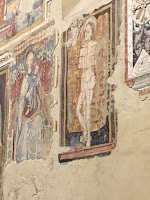Have you ever been asked by your grown children what you would like for Christmas? And replied, Nothing, we already have too much stuff. And then, quasi-jokingly, said, A dog. We miss our dogs so much. That is the short version of how Frida came to us. The long version goes into hours of research and inquiries within a 2000 mile radius, and organizing, mostly by our son-in-law.
We are an older couple of settled habits, and Frida is a puppy. In normal circumstances, of which there are none, our schedule would have remained intact, and our habits would continue, and Frida would adjust. That has not been the case. It turns out that the blood of Genghis Khan and Juana la Loca flows through the veins of Frida. The pleasant schedule we have developed over many years of cohabitation, has been transgressed and rewritten, according to her wishes and needs.
Around 4:30 am CSB, who thankfully is an early riser, takes Frida outside into the cold and the snow, so that she can perform her morning eliminations. Then he escorts her back to her crate so she can rest some more, with her pet mink. CSB leaves for work around 6:15. I am still sleeping. According to my preferred schedule, I wake up around seven and stay in bed with a pot of tea and write five hundred words. Not always the finest words, but still words. This is no longer possible. I still wake around 7, but I must then propel myself to the kitchen where Frida resides and rules. Depending on the weather, I pull on a pair of boots, a sweater over my pajamas, put on my down jacket, get a hat, and gloves or mittens. Then I open the crate with soothing words and pray that Frida will head directly out the back door and urinate. We were initially opposed to the idea that she would urinate on the back porch, but no longer. Now that we have so much snow, deeper snow than my boots can accommodate, and it is so cold, we have relented and allow Frida to perform the morning’s first official urination onto the snow that covers the back porch. After peeing, Frida comes back inside and expects breakfast. I feed her kibble enhanced with eggs and chicken bone broth. She eats and drinks quickly, while I would prefer to slowly sip hot tea and contemplate those five hundred unwritten words, and then make myself two four-minute soft boiled eggs, with soldiers. That’s when things get tricky. Frida loves my boots, and I need my boots to keep my feet warm and dry. I also cannot walk if Frida has attached herself to the little leather strap thing at the back of my L.L. Bean hunting boots. If I ask Frida nicely to let go of my boots, and even offer her a squeaky toy instead, she ignores me. If I remonstrate with her, and firmly take hold of her martingale collar, as advised by the dog trainer we have hired at huge expense, she continues biting at my boots and also nips at my socks and my pants. I have two ankles covered in small puppy-tooth scratches I could show you. Then, as instructed by the trainer, I try to put her back into the crate until she calms down. This only works if we are in the kitchen standing more or less next to the crate.
When we are outside and she nips at my boots, I can be as stern as I like, without interrupting Frida’s nipping in the slightest. According to various texts I have read, this behavior mimics how puppies would act in the wild, with their littermates, in establishing the power structure in the den. Frida is acting thus to assert her dominance over me. She is Alpha, and I am any other Greek letter you like. She is not wrong is assuming her Alpha-ness. In a world of equality among all living things, dogs and humans alike, Frida would most definitely be alpha to my omega. I am simply not the Alpha type, and Frida clearly senses this. However, we do not live in a fair or equal world, and as a human I have a few advantages. At least for now, I am bigger and stronger than she is. I control the food supply. I deliver the treats. I turn on the heat. And, as we did for the Pacha Mama in Santiago Atitlan, we make ritual offerings of squeaky toys, rubber bones, frisbees, and from Chewy.com, IQ treat dispenser balls to make her smarter. I have since rethought the IQ toys, because Frida is already smart enough for a dog.
 |
| Frida discovers snow |
When we are outside and she nips at my boots, I can be as stern as I like, without interrupting Frida’s nipping in the slightest. According to various texts I have read, this behavior mimics how puppies would act in the wild, with their littermates, in establishing the power structure in the den. Frida is acting thus to assert her dominance over me. She is Alpha, and I am any other Greek letter you like. She is not wrong is assuming her Alpha-ness. In a world of equality among all living things, dogs and humans alike, Frida would most definitely be alpha to my omega. I am simply not the Alpha type, and Frida clearly senses this. However, we do not live in a fair or equal world, and as a human I have a few advantages. At least for now, I am bigger and stronger than she is. I control the food supply. I deliver the treats. I turn on the heat. And, as we did for the Pacha Mama in Santiago Atitlan, we make ritual offerings of squeaky toys, rubber bones, frisbees, and from Chewy.com, IQ treat dispenser balls to make her smarter. I have since rethought the IQ toys, because Frida is already smart enough for a dog.
 |
| Exploring the hollow Catalpa tree |
As for the schedule, normally after my breakfast I will go to my desk and write letters to the editor, and answer emails from Nigerian princes asking for money, but no longer. After Frida has had sufficient time to digest her breakfast, which is hardly any time at all for a puppy, we head outside again. With any luck, I am wearing daytime clothes by now. I get my boots back on, often in a corner so that Frida cannot see me and lunge for the boots before we’ve accomplished any eliminations, then my down parka, hat, and gloves. I take hold of Frida’s leash and we head outside. Since the snow is so deep in the back yard, we can only go to the side yard where CSB shoveled paths to the Little Red House, the compost bin, and the bird feeder. I can stay on the paths, mostly, and Frida can jump in and out of snow drifts or run on the paths and crash into my legs. I throw sticks for her to retrieve and praise her to the moon when she does this. She takes her characteristic back squat and makes small piddles wherever and whenever she can. As Prufrock’s life is measured in coffee spoons, so Frida’s days can be measured out in pale yellow patches on snow. I have learned that this is her way of marking her territory, and by now, most of our property is under her hegemony. Then she has to choose the right spot for defecation. Frida will not defecate just anywhere, and certainly not where I might suggest.
Another issue is the leash. According to the trainer I am never ever to let her off the leash when we are outside. But what should I do when I am standing in the shoveled path, and Frida leaps through the deep snow toward the field, the woods and beyond? I drop the leash and let her run free. When I do this I think I am just being thoughtful, and allowing her to enjoy the freedom her young limbs are capable of. She thinks that I am subject to her desires, and incapable of reining her in. In other words, that she is Alpha. Having dashed off, with the leash trailing behind her, she finds a likely spot, circles it two or three times, sniffing out whatever scents there might be, then she turns away from any onlookers, arches her back, and neatly extrudes a longish tootsie roll onto the lovely white snow, while I surreptitiously watch to make sure she does the deed, and also praying that she doesn’t shit directly onto the pink leash that follows her. Later I will strap on my snowshoes and go around the yard picking up her poop with compostable baggies. According to the monks of New Skete, it is not advisable for the puppy to see me picking up her poop, or cleaning up her accidents inside, because then she will think my only purpose is to clean up after her. When I first read that I thought that maybe the monks, who in general are very strict about not anthropomorphizing one’s pets, in this case were endowing the puppies with more capacity for inductive reasoning than is likely. Now I am coming round to the monks’ view of things.
 |
After performing her toilette and chasing after leaves and twigs to her hearts’ delight, Frida is ready to head back inside and get warm. As am I. She charges across the snow, roars along the path, and dashes up the back stairs as if shot from a cannon, and careens directly into my boots. She takes hold of them with all the strength that razor sharp puppy teeth are capable of. Firmly, dominantly, I tell her to Drop it! Still attached to my boot she shakes her head fiercely, destabilizing me and reinforcing her grip on the leather. I have to physically detach her mouth from my boot, which explains all the scratches and cuts on my hands and wrists. Then, per the trainer’s directions, I must put her in the crate. Until she is repentant. That’s a joke; he didn’t use the word repentant. I, however, quickly repent of crating her up, so that in about fifteen minutes, long enough to maybe advance a load of laundry, I take her out of the crate and we go back outside, and repeat the drill.
Don’t think that I have an attachment to those L.L.Bean boots that makes them all the more tempting for Frida. Quite the contrary. I have another pair of boots that are warmer, and taller, thus allowing me to walk in higher snow. But they have a fur fringe on top and most disastrously, they have laces. Frida’s compulsion to nip, bite, cudgel, and own both the laces and the fur fringe is far beyond my ability to attempt training. Instead, I make do with what I hope are less enticing boots.
After lunch things get complicated by my hazard orange fleece gloves. Perhaps by midday the boots are boring her, so now whenever I am garbing up to head outside, Frida lunges for my gloves. It is too cold to be outside without gloves, and to let her grab a bright orange glove and run off with it, is to lose face completely, and acknowledge that I am not now nor will ever be Alpha material.
I am looking into the local options for Puppy Daycare. Yes, it exists.































